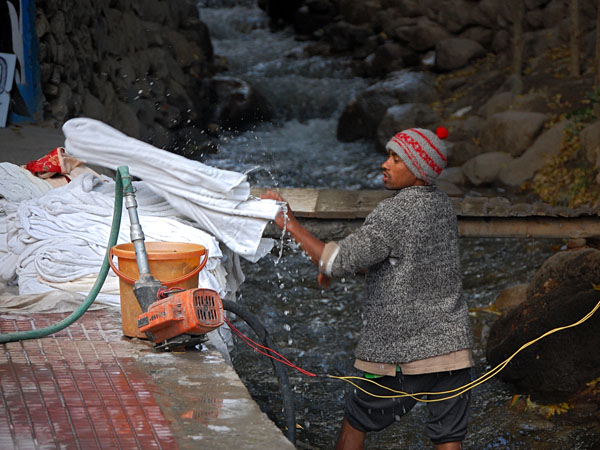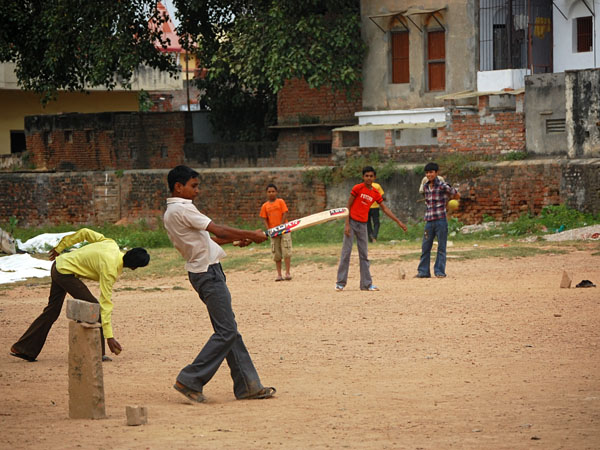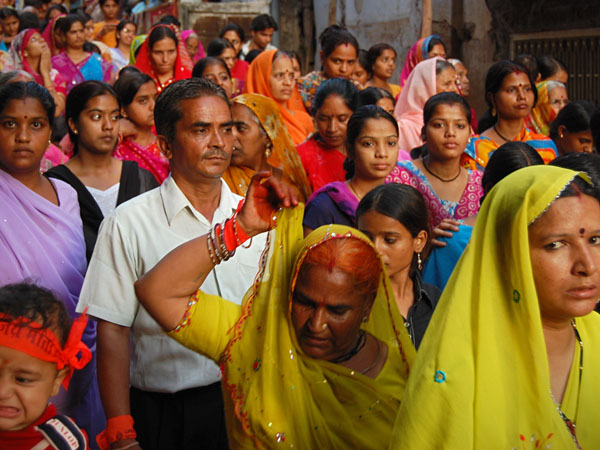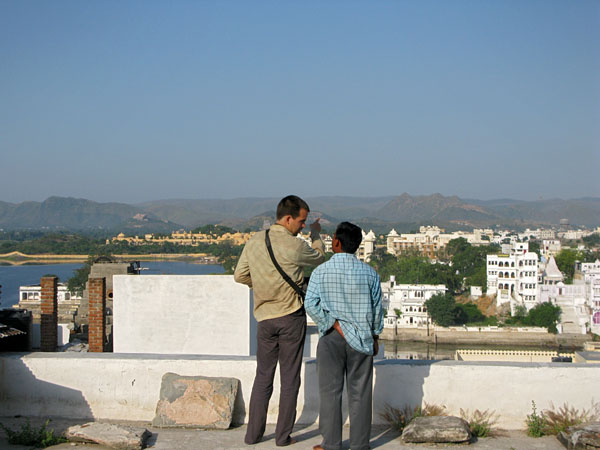Home-cooking Class in Jodhpur, India
Update August 14, 2012:
I just recieved the following email from Rekha, and it sounds like her shop and cooking classes are still alive and doing well!!! Please visit her at Spice Paradise if you find yourself in Jodhpur.
Dear Jamie Sinz,
If you remember in 2008 you come to a cooking class in Jodhpur and and learn some Indian dishes. I know that You may be remembering us but Jamie I thank that almighty and you from the bottom of my heart that you came to my home. That time no name to my shop also and today you see Spice Paradise is ranked number one in whole of Jodhpur and this is all because of you dear . You have build this place . Please forgive me that I remember you now . There was no computer in my home before so I was not able to see what a big things you have done for this place . Today also it is not there in any of the guide books but working well only because of you . I dont know how to use computer much so I saw your name and typed something . please come to jodhpur once again . I hope this small message will reach you.
On our way back to the guesthouse in Jodhpur, we stopped at the corner store to buy some water and a soda. It was like any other corner store in India…packets of shampoo hanging from the ceiling, beverages displayed on a counter, bags of snacks behind a glass cabinet, man sitting in the middle of it all serving customers. We asked for a bottle of cold water, and a woman appeared in a side door and invited us to come in as she pulled the water out of the refrigerator.
We walked through the door and were immersed in the smell of the freshly ground Indian spices that were displayed along every wall of the room. Our hostess handed us our cold drinks, and asked us to please sit in the two comfy upholstered chairs to the right to drink our water. For the record, we had no intention of drinking our water then and there…it just happened! We started talking with our hostess. She asked us questions. We asked her questions. We talked about the tragedy at the palace. We saw that she had two daughters, and she told us that today was the younger girl’s birthday. We told her our plans for traveling. She told us about her spice shop. Then she said that she would like to teach us how to cook Indian food. Why, sure, we would love for you to teach us how to cook Indian food. And at that, it was settled. We decided on a menu (Indian Chai, Saffron Lassi, Mixed Vegetables with Rice and Gutta, Shahi Paneer Curry and Chipatas) and price (Rs 200 per main dish, which totaled Rs600/person, or $13). We scheduled our rendezvous for 2pm the following afternoon.
When we arrived, our hostess/instructor, Rekka, was waiting for us. We started with small talk by asking how her daughter’s birthday party went, and she asked about our trip to the palace earlier that morning. Eventually, we gathered in her teeny tiny kitchen. Nik and I stood in the doorway as she stood in the 2-foot-wide “U” that was made by her worksurface, gas cooktop, pantry and sink. First, she taught us how to make Indian Masala Chai, which is a basic spice tea with milk. Masala is a general term for mixed spices. After combining milk, black tea leaves and masala, she brought the mixture to a boil 5 times. This trick gives a richer flavor as well as kills any bacteria that might be in the milk.
During this very brief demonstration, Nik and I were able to ask all kinds of questions about an Indian kitchen…
Where does the milk come from? It comes from the family cow every morning, and is boiled (otherwise known as pasteurizing) before storing it in a metal bowl on the kitchen counter. They only extract enough milk for one day so that nothing is wasted. If there is extra at the end of the night, they make milk shakes!
What kind of pots do you use? Aluminum because they are lightweight and foods don’t stick. In the old days, they used copper, but now they are too expensive and hard to clean.
Where does your drinking water come from? The house water is piped in from a huge storage tank on the roof. Each morning, Rekka boils water from the tap, then stores it in a large earthen jar under the counter. There is always a small metal cup handy to dip into the pot and retrieve water for drinking and cooking. She also cleans the pot every day before adding the sterilized water.
What kind of oil do you use? Soy bean oil is the easiest and cheapest to find, and it’s kept in a large metal canister just above the stove.
What do you do with leftovers? She doesn’t cook enough to have left overs. Everything is bought and cooked fresh every day. (I bet that many Indian houses don’t even have refrigerators)
Once the Chai was finished, we poured ourselves a glass and sat down in our comfy chairs for a lesson on Indian spices. She started by explaining all of the spices that she puts into her very special Masala Chai mix: Cardamon, Dry Ginger, Black Pepper, Nutmeg, Cinnamon and Cloves. She had detailed explanations for each one’s use. For example, Cardamon is supposed to aid with digestion and Dry Ginger is good for clearing your sinuses…or was it the other way around? I don’t remember, but they were great stories to listen to.
When she finished the spice explanations for the Tea, we asked for more. What about Saffron? And do you use Vanilla? What about Green Pepper? At this point she pulled out her big bowl of spices and walked through every single one she carries in her store. Nik and I were captivated.
Our cups were empty, and it was time to go to the market. Rekha handed us a grocery list, and asked one of the neighborhood girls to walk us to her brother-in-law’s vegetable stand a few blocks away. He weighed out various fresh vegetables, and then our escort walked us to a general store to pick up the final ingredients: heavy cream and yogurt. We gave her a 5 Rupee coin to say thanks, and we were back in class.
Next up was the Saffron Lassi. A lassi is a traditional Indian drink made by blending fresh yogurt, water, spices and occasionally fruit. Sometimes they are savory, and sometimes they are sweet. Our sweet Saffron variety is a specialty of Jodhpur, and is made with yogurt, sugar, cardamon and a pinch of saffron that has been sitting in luke warm water for 5 minutes so that the color and flavor is released. After blending, we chilled the mixture in the refrigerator while we prepared the next dish, Mixed Vegetables with Rice and Gutta. Gutta, also spelled Gatte or Gatta, is a small chickpea flour dumpling that is more often used in a curry, but was very tasty in our vegetable rice! The other delicious ingredients included: Raisins, Cashews, Jalepeno Peppers, Lemon, Cauliflower, Potatoes, Tomatoes, Coriander, Tumeric, Red Chili, and of course, Bismati Rice.
Our second main dish was Shahi Paneer Curry. Shahi means oil, and Paneer means cottage cheese…so this is curry with oil and cottage cheese! Our ingredients included cottage cheese (duh), onions, ginger, tomatoes, green pepper and spices. Because we were foreigners, she added a little milk and cream at the very end so that it wasn’t quite as spicy, but I think it would be good either way.
Next, she challenged us to make Chapati. Chapati is a basic, unleavened Indian flatbread that is often paired with dal (lentil soup) or curry, and is used to pinch each bite of the cooked dish, therefor eating without utensils. Nik helped her make the dough, then she demonstrated how to make the individual pieces. She pinched off a small ball of dough, made it into a perfect ball with her hands, then rolled it out on a floured surface into a perfect 10″ circle using a teeny tiny wooden rolling pin with fixed handles. The best part is that once the dough was on the table, she never touched it again with her hands. Just by applying pressure to one side, she turned the dough to roll it evenly. One day, I will master that skill!! Then she picked the millimeters thick circle up with her right hand, threw it into her left hand, then threw it into the hot skillet. After the first side was browned, she flipped it. After the second side was browned she picked it up with wooden tongs, removed the skillet from the eye, and placed the Chapati directly on the open flame. To our amazement, the whole thing blew up like a balloon!!! She pulled it off of the flame and placed it on a plate in front of us, then added a bowl of the hot curry topped with a little grated cheese and fresh coriander…but before we could eat, we had to make our own!
We were both moderately successful…neither of our circles were quite circular, and neither were quite as thin, but they both puffed up like a blowfish!!! Finally, we could eat the beautiful curry and our hard earned Chapati. As we did so, she showed us how to make Butter Chapati, spread butter or ghee (clarified butter) on the dough before you place it on the skillet, and Masala Chapati, roll out the dough, sprinkle spices down the middle, fold the dough over the spices, roll it into a tube, then make a spiral and roll the dough out again so that the spices are distributed evenly.
After we finished, I requested to have a second bowl of the Saffron Lassi and the three of us sat down in the comfy chairs and chatted a little more. She asked how we liked the class, and wondered if there was anything she should do differently. We both agreed that it was fantastic, and couldn’t imagine how it could be improved. I told her that I felt like my aunt was teaching me how to cook. As I was saying this, I realized that she was 5 years younger than me, so I quickly added…or sister.
She also asked us for advise on how to get more students. She has grand ideas of expanding her kitchen so that she can teach up to 8 or 10 people at a time, and she would love to have a more steady flow. Right now she is depending on a couple signs in front of her family’s shop and word of mouth. Of course, word of mouth is the best way, so this post is my way of helping a friend. She does not have a website, and you can’t find her in any guidebooks. So if you are in Jodhpur and are interested in spices, cooking or a first hand dose of Indian culture, I recommend that you stop by and see Rekha. Spend an hour chatting about spices, or spend 6 hours (like we did) learning how to cook.
Here is her information, and if you have any questions, please leave a comment or email Rekha yourself.
Shop Name: Spice Paradise
Her name: Rekha Sharma
Her husband’s name: Anil Kumar Sharma
Their email: anilhumar20042003@gmail.com
Location: Girdi Kote & Amar Chowk; From Shivam Paying Guesthouse, turn right and you will run directly into the shop.




















